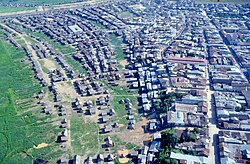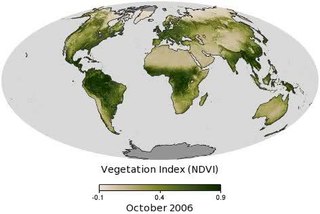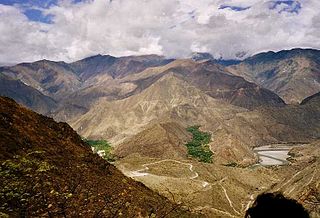
The Tigre River is a Peruvian tributary of the Marañón River west of the Nanay River. It is navigable for 125 mi (201 km) from its confluence with the Marañón. It forms from the confluence of the Ecuadorian rivers Cunambo and Pintoyacu at the Peruvian border. Like the Nanay, it flows entirely on the plains. Its mouth is 42 mi (68 km) west of the junction of the Ucayali River with the Marañón. Continuing west from the Tigre along the Marañón River we have the Parinari, Chambira, and Nucuray, all short lowland streams, resembling the Nanay in character. Tigre is Spanish for "tiger" the vernacular name in the region for the Jaguar.

The Ucayali River arises about 110 km (68 mi) north of Lake Titicaca, in the Arequipa region of Peru. The Amazon River takes its name close to Nauta city, at the confluence of the Marañón and Ucayali rivers. The Ucayali becomes a major tributary of the Amazon River. Navigation was blocked by lengthy sections of rapids. The city of Pucallpa is located on the banks of the Ucayali.

Huánuco is a department in central Peru. It is bordered by the La Libertad, San Martín, Loreto and Ucayali regions in the north, the Ucayali Region in the east, the Pasco Region in the south and the Lima and Ancash regions in the west. Its capital is the city Huánuco.
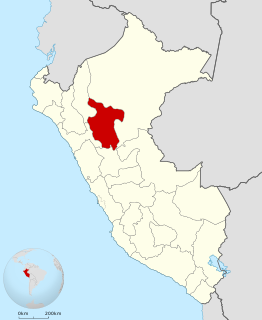
San Martín is a department in northern Peru. Most of the department is located in the upper part of the Peruvian Amazon rainforest. Its capital is Moyobamba and the largest city in the department is Tarapoto.

Punchana is the capital of the Punchana District in the Maynas Province of the Loreto Region in northeastern Peru, in the Peruvian Amazon Jungle. It is a neighborhood on the outskirts of the city of Iquitos, located on the Amazon and the Nanay Rivers.
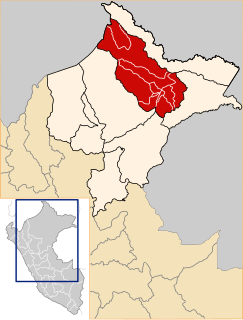
Maynas is a province in the Loreto Region in northeastern Peru. Its capital, Iquitos, is also Loreto's regional capital and the largest city in the Peruvian Amazon Rainforest.

The territorial dispute between Ecuador and Peru was the source of the longest-running international armed conflict in the Western Hemisphere. This dispute was a consequence of each country's interpretation of what Real Cedulas Spain used to precisely define its colonial territories in the Americas. After independence all of Spain's colonial territories signed and agreed to proclaim their limits in the basis of the principle uti possidetis juris which accepts the Spanish colonial borders of 1810 as the borders of the new republics. Thus the borders of Gran Colombia which included Ecuador, Colombia and Venezuela would follow the borders of the Viceroyalty of New Granada, and Peru the Viceroyalty of Peru in 1810. However, Peru was not satisfied with this and tried to set the date of her Uti Possitedis to 1824- a time when Peru was officially independent with territories Peru militarily occupied since 1820. Tumbes and Jaen de Bracamoros, to which Peru had no colonial titles, were territories that declared their independence in 1820 and were militarily occupied by Peruvian patriot forces that convinced the people in these territories to join Peru. Because of this, Peru claims that part of its western territorial borders where it lacks title is derived from free determination of its people in the border areas after independence. In the eastern section known as Maynas or Mainas, which was the sparsely inhabited and entirely Amazon Basin, Peru bases its legal claims on the disputed Real Cedula of 1802. Gran Colombia which declared independence 2 years earlier in 1819 and helped to liberate Peru in the Battle of Junin and Ayacucho bases its rights on the clear and undisputed Real Cedulas of 1717, 1739 and 1740 and declares that the Real Cedula of 1802 is not political in nature, but was meant only for ecclesiastical and military jurisdiction.

Yurimaguas is a port town in the Loreto Region of the northeastern Peruvian Amazon. Historically associated with Maynas, the culturally diverse town is affectionately known as the "Pearl of the Huallaga". Yurimaguas is located at the confluence of the majestic Huallaga and Paranapura Rivers in the steamy rainforests of northeastern Peru. It is the capital of both Alto Amazonas Province and Yurimaguas District, and had a population estimated at about 62,903 inhabitants (2017).
Cocama (Kokáma) is an indigenous language spoken by thousands of native people in western South America. It is spoken along the banks of the Northeastern lower Ucayali, lower Marañón, and Huallaga rivers and in neighboring areas of Brazil and an isolated area in Colombia. There are three dialects. The robust dialect is known as Cocama, Kokama, Kukama-Kukamiria, Ucayali, Xibitaoan, Huallaga, Pampadeque, and Pandequebo. By 1999, Cocamilla (Kokamíya) was moribund, being only spoken by people over 40.
Ubigeo is the coding system for geographical locations in Peru used by the National Statistics and Computing Institute to code the first-level administrative subdivision: regions, the second-level administrative subdivision: provinces and the third-level administrative subdivision: districts.

Belén District is one of thirteen districts of the Maynas Province in Peru. Belén lies at the edge of the city of Iquitos, in the floodplain of the Itaya River. It is home to some 65,000 people, most of them poor, and many of whom live in extreme poverty. The housing does not have clean water, proper sanitation, or electric power distribution.
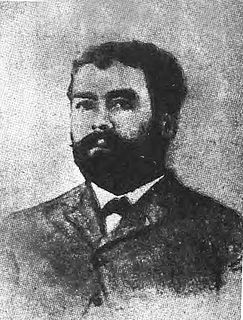
Carlos Fermín Fitzcarrald was a Peruvian rubber baron. He was born in San Luis, Ancash.

The Tapiche Reserve is a private conservation property located in Tapiche District, Requena Province, Loreto Region in Peru. The 1,540 hectare reserve, accessible only by waterway, is located 340 km up river from Iquitos on the Tapiche River. The reserve comprises several types of lowland Amazonian forests, including igapo, varzea, and terra firme. The reserve represents one of the few areas in the Amazon basin where these forest types can be found in close proximity. The reserve spans both sides of the Tapiche River east of the Ucayali River; and is home to endangered species such as jaguar, bald uakari, giant armadillo, the Brazilian tapir, the Amazonian manatee, harpy eagle, cedar, mahogany and others. Inside the reserve, there are bodies of water and swamps including lakes, canals, oxbows, aguajales, and restingas. It has annual temperatures ranging from 25 °C (77 °F) to 33 °C (91 °F) and an annual rain fall of about 3 meters, permitting an immense variety of species to thrive in the area. A land survey and rapid species inventory of Tapiche Ohara’s Reserve was performed in 2011. The species inventory is reproduced below in table format. The reserve is designated by the Peruvian government as a Private Conservation Area (PCA).

The 2012 Loreto floods is an orange-alert weather event that affected Loreto Region, Peru that took place in the first months of 2012. February and March were the wettest months along the Peruvian Amazon. The area most affected in Loreto are villages, towns and coasts of the provincial capital, Iquitos. It is the first and strongest historical flood series in the history of Loreto, preceding the floods in 1986.
Lake Zungarococha (possibly from Quechua sunkaru a South American cat fish, qucha lake, is a lake in Peru. It lies near the Nanay River, southwest of Iquitos, in the Loreto Region, Maynas Province, San Juan Bautista District.
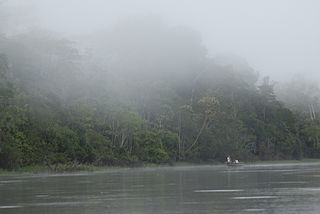
Tamshiyacu Tahuayo Regional Conservation Area is a protected area located south east of Iquitos, extending over the Peruvian department of Loreto, provinces of Maynas, Ramón Castilla and Requena. It was established by the Peruvian Ministry of Environment on May 15, 2009. The reserve is managed and funded by the Regional Government of Loreto.

The Itaya River is a tributary of the Amazon River via the Nanay River in northern Peru. The Itaya flows alongside the city of Iquitos and the district of Belén.
